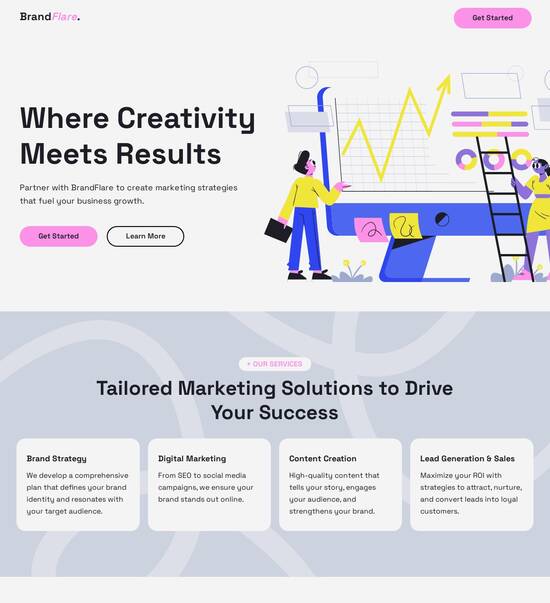
Classic blog page templates
Use TemplateAbout template
Use classic blog page templates and stay true to your brand identity. Resonate with your audience today.
Recommended templates

Easy to build without coding
With the intuitive drag-and-drop builder, anyone on your team can create high-converting pages without any knowledge of code or design. Make enhancements to your landing page with custom widgets using Javascript, HTML/CSS, or third-party scripts.

Multiple layouts for any industry and goal
Select from 500+ landing page layouts built to boost conversions across industry-specific scenarios. Customize them by adjusting fonts, adding images, and generating on-brand content with the AI assistant. Quickly scale with Instablocks® and Global Blocks that you can save, reuse, and update globally.

Loads fast and looks polished on any device
Every template is responsive, which means they present professionally on any device and load blazingly fast with our Thor Render Engine. You can also power them up with Google AMP technology to deliver an unparalleled mobile experience and drive higher conversions.

Robust analytics & experimentation
Get real-time updates and reporting across all your devices, showing the number of visitors, conversions, cost-per-visitor, and cost-per-lead. Launch AI-powered experiments, run A/B tests, and use heatmaps to analyze user behavior, then optimize your landing page to maximize conversions.







Easy to build without coding
With the intuitive drag-and-drop builder, anyone on your team can create high-converting pages without any knowledge of code or design. Make enhancements to your landing page with custom widgets using Javascript, HTML/CSS, or third-party scripts.
Multiple layouts for any industry and goal
Select from 500+ landing page layouts built to boost conversions across industry-specific scenarios. Customize them by adjusting fonts, adding images, and generating on-brand content with the AI assistant. Quickly scale with Instablocks® and Global Blocks that you can save, reuse, and update globally.
Loads fast and looks polished on any device
Every template is responsive, which means they present professionally on any device and load blazingly fast with our Thor Render Engine.
Robust analytics & experimentation
Get real-time updates and reporting across all your devices, showing the number of visitors, conversions, cost-per-visitor, and cost-per-lead. Launch AI-powered experiments, run A/B tests, and use heatmaps to analyze user behavior, then optimize your landing page to maximize conversions.
All the features you need to build lead-generating landing pages
Explore more featuresLearn how to build top-performing landing pages for any goal
FAQs
Leading the way in building high-performing landing pages





Unlocking the potential of Instapage for effective landing page strategies
In today's competitive digital marketing landscape, having powerful landing page strategies is crucial for capturing leads and driving conversions. Instapage's advanced features and intuitive interface make it the ideal platform for marketers seeking to enhance their campaigns, regardless of team size or budget. With over 100 customizable templates and robust optimization tools, Instapage empowers users to elevate their marketing efforts effectively.
Understanding the key components of Instapage
Instapage stands out with its unique features designed specifically for marketers. The platform's emphasis on user-friendly design enables quick creation of high-converting landing pages without needing any coding knowledge. Additionally, its collaboration tools help streamline feedback and revisions, making it easier for teams to work together towards achieving common goals.
- Templates & Lead Gen Elements: Instapage offers access to over 100 ready-to-use templates, allowing marketers to easily launch pages that capture leads.
- Optimization: Built-in A/B testing and heatmaps enable users to analyze on-page behavior and improve landing page performance.
- Personalization: Dynamic text replacement and audience-level metrics allow for tailored content that resonates with specific visitor segments.
Setting up your first landing page on Instapage
Creating your first landing page is straightforward with Instapage. Begin by selecting a template that aligns with your campaign objectives. You can customize various elements such as images, headlines, and calls-to-action to match your brand's aesthetic and message.
Enhancing user experience through optimization
Once your page is set up, focus on optimization strategies that drive conversion rates. Here’s how:
- Utilize A/B testing: Experiment with different headlines or visuals to determine which options yield the highest engagement.
- Implement heatmaps: Leverage heatmaps to gain insights into visitor behavior and adjust your layout accordingly.
- Monitor analytics: Use Instapage's analytics dashboard to track performance, revealing which areas need improvement.
Personalizing your landing page for better audience alignment
To truly connect with your audience, personalization is key. This can be done by leveraging Instapage's dynamic content features to create tailored experiences for different user segments. Consider implementing the following:
- Dynamic text replacement: Customize messages based on the originating source of the traffic, ensuring relevancy.
- AdMaps integration: Align your ads with corresponding landing pages to enhance user journey consistency.
- Audience-level metrics: Track interactions to further refine engagement strategies based on specific audience behaviors.
Utilizing Instapage can transform your digital marketing campaigns by enhancing lead capture and accelerating conversion rates. Don't underestimate the power of a well-optimized landing page in boosting your ROI.
Are you ready to take your marketing strategy to the next level? Explore the full potential of Instapage today and create landing pages that not only engage but convert.
People also ask about Classic blog page template
Classic blog page template: A comprehensive guide
Understanding the essence of classic blog page templates
A classic blog page template serves as the foundational layout that shapes the visual and functional aspects of a blog. Its primary purpose is to provide bloggers with a framework, making it easy to present their thoughts and ideas effectively. By adhering to a structured design, blog page templates allow for seamless content creation and management, ensuring that readers have a consistent and pleasant experience while navigating the blog.
The role of blog page templates in an online content strategy cannot be overstated. These templates act as the backbone of a blog's identity, providing a cohesive look that reflects the blogger’s style. Additionally, they assist in organizing content effectively, and ultimately enhance engagement, promoting longer visits and repeat traffic.
Importance in user experience
User experience (UX) is critical for keeping readers returning to a blog. Classic blog page templates significantly enhance readability and navigation, ensuring content is easily accessible. Structured layouts allow readers to quickly find important sections like the latest posts or categories, which contributes to improved engagement.
Furthermore, maintaining visual consistency across posts helps in establishing a brand identity. This uniformity can increase the blog's credibility, making users more likely to return. By utilizing an appropriate template, bloggers can ensure their content appears professional and is easy to digest.
Core features of classic blog page templates
Classic blog page templates come equipped with various core features that enhance aesthetics and usability. One pivotal aspect is the layout options available to bloggers. While classic layouts often present content in a single-column format, grid layouts can provide a more modern approach with multiple columns of content. Both styles have their advantages and disadvantages. Classic layouts tend to create a straightforward browsing experience, whereas grid layouts can showcase visual content more dynamically.
The importance of responsive design cannot be overstated. As more users access content on their mobile devices, blog templates must adapt seamlessly to various screen sizes. Mobile optimization ensures that all visitors, regardless of their device, enjoy a smooth experience that maintains the integrity of the blog’s design.
Visual elements
Visual elements play a crucial role in keeping readers engaged. Classic blog templates typically include headers, footers, and sidebars that provide consistent navigation and showcase key information, such as categories and popular posts. Additionally, configurable image placements, like featured images and galleries, enrich the visual appeal of the blog, helping to draw readers in and reinforce the content's message.
Typography is another critical component that impacts readability. Selecting appropriate font styles, sizes, and colors enhances the overall aesthetic and comfort for users. A well-chosen typeface can reflect the blog's personality and make a lasting impression on readers.
Integration capabilities
Classic blog page templates also emphasize integration capabilities, which can elevate the blog’s performance significantly. SEO-friendly features allow bloggers to optimize their content for search engines, potentially improving visibility. Additionally, integrating social media buttons can encourage readers to share posts, extending the reach beyond the blog's native platform.
Moreover, robust comment systems foster user engagement, allowing readers to interact directly with the content. This sense of community not only boosts user satisfaction but can also provide valuable feedback and insights.
Customization capabilities
A significant advantage of using classic blog page templates is the flexibility they offer to personalize the design. Bloggers can modify color schemes and implement their branding without needing technical skills. This customization ensures that each blog reflects the owner's individuality while adhering to essential design principles.
Many classic blog templates come equipped with options to modify layout structures without requiring any coding knowledge. This democratizes blog design, permitting even those with limited technical experience to curate a unique space that resonates with their audience.
Widgets and plugins
The use of widgets and plugins can significantly enhance the functionality of a blog. Popular plugins can be employed for various purposes, such as SEO optimization, security enhancements, and improved analytics. Likewise, leveraging recommended widgets can elevate blog aesthetics and utility, providing features like social media feeds, recent posts, or even newsletter sign-ups.
Creating a unique identity is essential for standing out in today's crowded digital space. Bloggers can achieve this by incorporating distinctive elements into their templates, such as custom logos, personalized headers, or unique navigation menus. Examples of successful themed blogs can often serve as inspiration for new bloggers seeking to carve out their niche.
The benefit of dynamic listings
Dynamic listings are vital features in classic blog page templates, particularly when showcasing recent posts. Highlighting new content not only keeps the blog fresh but also encourages returning visitors to explore what’s new. An effective strategy for organizing blog post listings might include categorizing content by date, popularity, or theme, making it easier for readers to find relevant articles tailored to their interests.
Featured content sections can be employed to draw attention to top articles or related posts. By developing specific areas that spotlight exceptional or timely content, bloggers can provide readers with a curated experience while encouraging further exploration through categories and tags that enhance discoverability.
Effective use of news and updates
Keeping readers informed is a core aspect of effective blogging. Implementing a dynamic news section within a classic template can serve as a valuable resource for readers. By regularly updating this section with relevant articles or industry news, bloggers can maintain engagement and position themselves as credible sources of information. Engaging headlines and succinct summaries can entice readers to click through to the full articles.
Moreover, integrating promotional banners into blog templates allows bloggers to share exclusive discounts and promotions quickly. Best practices for highlighting special offers include strategic placement within the content and ensuring the messaging is clear and appealing. Crafting compelling calls to action is essential to driving conversions stemming from these promotions.
Enhancing reader interaction
Interactivity is a cornerstone of successful blogs. Subscription features, such as email inbox systems for newsletters, provide a direct line of communication between bloggers and their audience. Capturing reader emails directly from the blog is beneficial for keeping followers updated on new content and relevant announcements, effectively increasing the blog's reach.
Driving user engagement can be achieved by encouraging comments and feedback through aesthetically pleasing designs. Elements such as user-friendly comment sections can invite readers to share their thoughts easily. Additionally, integrating polls and surveys within posts can foster interaction, making readers feel involved in the community, ultimately building loyalty.
Analytical tools for blog performance
To enhance blogging performance, analyzing engagement metrics is crucial. Understanding reader behavior through analytics can guide content strategy and improve user experience. Various tools are available to monitor interactions, providing insights into which posts resonate most with the audience. With that information, bloggers can adjust their approach to meet reader preferences effectively.
A/B testing template variations allows bloggers to experiment with different designs based on reader feedback. Testing various elements, from colors and fonts to layout structures, can help ascertain what works best. Interpreting A/B test results accurately can lead to optimized templates, significantly enhancing user experience and increasing engagement.
Future trends in blog page templates
The evolution of design preferences influences the ongoing development of classic blog page templates. A noticeable trend is the shift toward minimalist designs that prioritize clean lines and whitespace, contrasting with content-rich layouts that emphasize multimedia. As consumer behavior changes, the demand for speed and performance in loading times has escalated, making it a crucial consideration for template developers.
Looking ahead, technological advancements will shape the future landscape of blog page templates. The application of AI and machine learning in template customization could lead to more personalized user experiences, adapting layouts dynamically to individual reader preferences. As voice and visual search capabilities evolve, blogs must also adapt to maintain relevancy and optimize their templates accordingly.
Conclusion of insights
In conclusion, classic blog page templates encompass numerous features and benefits that contribute to a successful blogging strategy. They serve as essential tools for enhancing user experience, enabling customization, and facilitating engagement. By adopting a well-structured template, bloggers can create visually appealing and functional sites that entice readers and keep them coming back.
As the digital landscape continues to evolve, embracing classic blog page templates can significantly enhance blogging performance and foster user satisfaction. Understanding the essential elements of these templates will not only help bloggers create engaging content but also establish a strong online presence that resonates with their audience.
Ready to skyrocket conversions?
Supercharge your ad campaigns with high-performing landing pages
Get started














